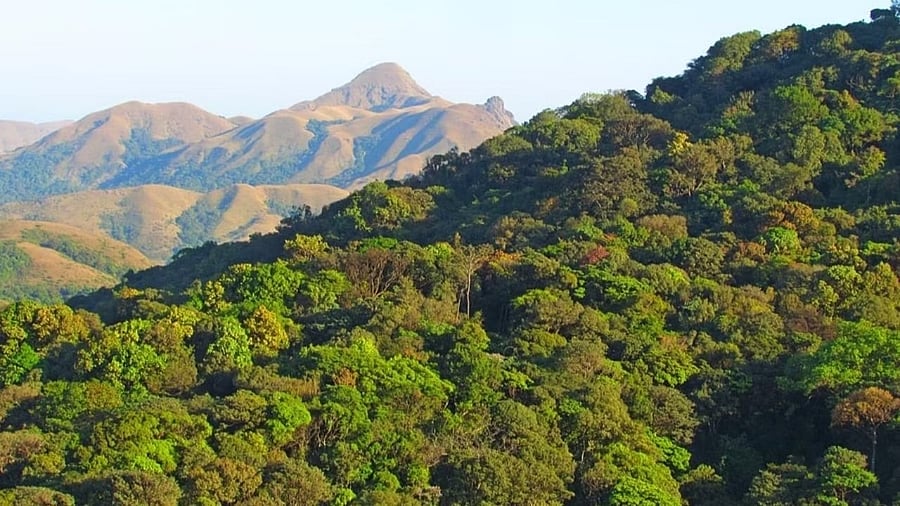
Representative image showing a forest.
Credit: DH Photo
Forests are not mere clusters of trees or collections of flora and fauna. They are living ecosystems—home to immense biodiversity, natural carbon sinks that regulate climate, purify air and water, and sustain countless life forms. Karnataka has approximately 4,067 million hectares of natural forests, covering around 21% of its geographical area.
Successive governments have rightly emphasised the importance of protected areas. Karnataka has notified five tiger reserves, 36 wildlife sanctuaries, and 19 conservation reserves, bringing 1.134 million hectares of forests under the Protected Area Network. The state proudly holds the largest population of elephants in the country (6,395) and ranks second in tiger numbers (563).
However, Karnataka is also a state of growing aspirations, expanding infrastructure, and increasing population density. As development progresses, so does the complexity of balancing human needs with environmental stewardship. One of the most pressing manifestations of this tension is human-wildlife conflict.
A number of families still live in acute poverty within protected forests. In the Kali Tiger Reserve (KTR), 71 hamlets are home to nearly 2,000 families; the Nagarhole National Park (NNP) has 34 hamlets with about 1,280 families; and the Biligir Ranganatha Tiger (BRT) Reserve houses around 1,662 families across eight villages. This honeycomb of habitations—connected by long footpaths—exposes people to fatal encounters with wildlife and disrupts the natural foraging and breeding pattern of wild animals.
Over the last five years, Karnataka has lost 254 human lives due to wildlife encounters—a stark reminder of the strained coexistence between people and animals. In response, the government has provided compensation of Rs 165 crore for deaths, crop damage, cattle loss, and property destruction. Yet the number of conflict incidents continues to rise, driven by habitat degradation, fragmented wildlife corridors, and limited livelihood options for forest-dependent communities.
For generations, indigenous and forest-dwelling communities in Karnataka have lived sustainably within forests, depending on them for food, firewood, and shelter. Their relationship with the forest has been symbiotic. But in recent decades, shrinking natural resources, population growth, and limited access to services have pushed many of these communities into poverty.
Though their traditional presence is historically rooted, it increasingly clashes with the prevalent conservation laws that prohibit human activity in core protected zones. The Forest Rights Act (FRA), 2006, attempted to address this by granting individual and community rights over forest land to those residing there prior to 2005. While this provides legal legitimacy to their presence, it does not alleviate their poverty.
Under FRA, the land remains classified as forest land—it cannot be sold, mortgaged, or developed beyond a limited scope. What appears on paper to be an asset is, in reality, a liability—a plot of land that cannot lift a family out of poverty.
There is a need for a shift from symbolic recognition to real, sustainable empowerment—integrating forest communities into the economic and social mainstream without disconnecting them from their ancestral roots.
The real breakthrough lies in redefining the forest boundary—not as a line of exclusion, but as a shared space of opportunity. Instead of permitting unregulated human activity or introducing capital-intensive infrastructure in critical wildlife habitats, “green corridors of livelihood”— zones that enable sustainable human activity and also preserve biodiversity—must be created.
These fringe zones could house eco-sensitive employment hubs offering:
Skill-based jobs in ecotourism, protection, and nature guides
Livelihoods in forest-friendly agriculture and handicrafts
Roles in conservation science as forest guides, biodiversity monitors, and climate data collectors
By remaining close to the forests, communities can preserve their cultural roots while gaining access to modern amenities—education, healthcare, roads, electricity, and sanitation—not as charity, but as a shared national investment. The Government of India, through the Ministry of Environment, Forest and Climate Change (MoEF&CC), has already laid the groundwork. Following the 2008 Supreme Court’s order, the MoEF&CC issued a circular in September 2009 allowing legal status change of forest land under the Forest (Conservation) Act, 1980, for the relocation and rehabilitation of villages from National Parks, Wildlife Sanctuaries, and Tiger Reserves.
This land, unlike FRA-entitled plots, comes with full ownership rights—allowing beneficiaries to build homes, farm, avail credit, and participate in development schemes. These rights are inheritable, monetisable, and legally recognised under the revenue system, unlike the restricted FRA titles. This legal clarity is crucial for any long-term poverty alleviation strategy.
For this vision to succeed, collaboration between the Forest Department and the Tribal Welfare Department is essential. While the Forest Department must identify degraded forest land at the fringes of national parks and facilitate legal reclassification, the Tribal Welfare Department should take the lead in providing infrastructure and social services.
This is more than a conservation model; it is a moral rebalancing. For too long, forest communities have been viewed as threats to conservation. They must now be recognised for what they truly are—co-guardians of India’s natural heritage.
Let the forests live. Let their people truly live too.
(The writer is with IFS, Government of Karnataka)